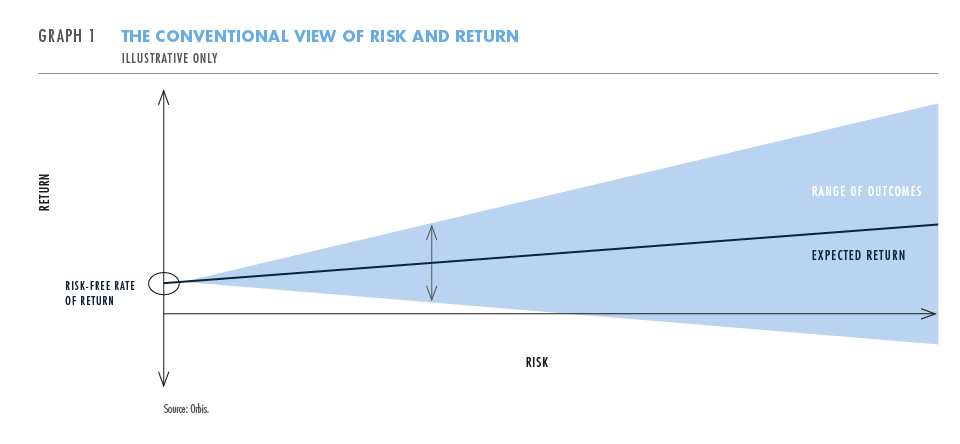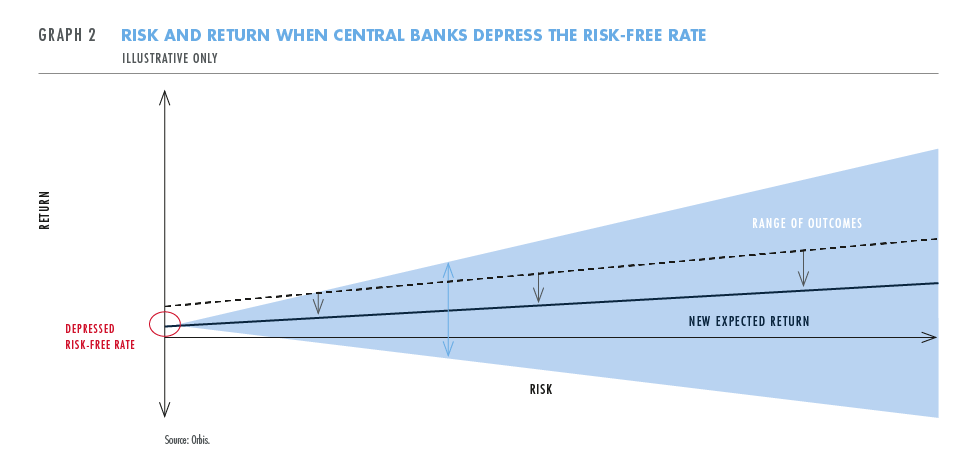Ben Preston and Maurits Ovaa explain why Orbis believes minimising losses is arguably more important than maximising gains at a time when many stock markets in the developed world appear fully valued. That’s not to say attractive investment ideas cannot be found in this environment, but it does mean that even more vigilance is needed than usual when assessing the risk-return proposition in individual shares.
At Orbis and Allan Gray, our approach to managing risk has always differed from the conventional approach. Whereas many investors define ‘risk’ in terms of short-term volatility or the risk of differing from a benchmark (tracking error), our focus is always on avoiding permanent loss of capital. We’ll happily tolerate periods of short-term volatility and underperformance – indeed this is often the price we must pay for long-term success – but the longer-term risk of simply losing our clients’ money is the one that keeps us awake at night. To see how this differs from the conventional view of risk, consider Graph 1, the classic textbook view of risk and return. The upward-sloping line suggests a strong link between the amount of risk you take and the returns that you can expect. It’s easy to forget that there is a wide range of outcomes at each point along the line. When you take risk on a given investment, you may be handsomely rewarded... or you may end up nursing a heavy loss. Said differently, the realised return may have nothing to do with the expected return implied by the level of risk you’ve taken.

Caught between a rock and a hard place
In today’s market environment, we believe the actions of central banks have deliberately shifted the classic risk-reward line downwards, by depressing the left-hand end of the line (the ‘risk-free rate’) and letting market forces take care of the rest (see Graph 2). With investors having been successfully herded into riskier assets, asset prices have risen all along the risk spectrum, a boon to investors over the last few years. But with higher prices come lower subsequent returns, leaving today’s investors facing a tough choice. They can either shift to the right and take on more risk in pursuit of the returns to which they have become accustomed, or they can reduce risk and settle for lower returns. Neither choice – lower returns or higher risk – is particularly appealing. A popular response to this dilemma has been to load up on stocks that are considered ‘stable’ or ‘defensive’, including shares of companies that make food, beverages, and household staples. Telecoms and utilities have also been a popular choice. While we sympathise with the plight that has encouraged many investors to seek the apparent ‘safety’ of these investments, we respectfully beg to differ with their conclusion. By flocking to the same areas of the market and pushing valuations up to what we believe are dangerous levels, defensive investors may end up being their own worst enemies.

Price is more important than timing
Under our definition of risk, we believe the best way to preserve purchasing power is to focus on assets that are trading well below what they are worth, and the best way to destroy it is to pay more for an asset than it is worth. In the short term, this may mean bearing substantial risk of uncertainty, volatility, and underperformance. But in the long- term, we believe these risks pale in comparison to the risk of holding an asset which proves less valuable than one paid for it. We’d rather take the small-and-obvious risks to avoid the bigger-but-less-appreciated ones.
Focus on assets that are trading well below what they are worth...
A good example is Russia’s Sberbank. Few things scream ‘risk’ as loudly as a Russian bank! But not everything that screams loudly is telling the truth. Sberbank is undoubtedly in both a market and sector that many investors have loved to hate. When we first invested in Sberbank two years ago, pessimism about Russia was unusually high, allowing us to buy a dominant banking franchise at a very compelling discount to its intrinsic value on an absolute basis and, on a relative basis, to its banking peers elsewhere in the world. Initially, we took our share of pain. Along with other Russian stocks, Sberbank shares were hit hard by the combination of sanctions and the collapse in oil prices. The stock was a drag on the Orbis Global Equity Fund’s performance in 2014. Since then, not only has Sberbank made a positive contribution to performance over the fullness of our holding period, but it still continues to look attractive.
This is what we mean by looking beyond short-term risks as we seek to protect and enhance our clients’ capital for the long-term. With hindsight, it would have been nice to time our investment in Sberbank precisely at the bottom, resulting in lower risk of loss, and even higher returns. But timing has never been our strong suit — indeed, we would be sceptical that it is anybody’s. Market prices are inherently volatile over short time periods, and we have found it much more effective to focus on buying shares at the right price than at the perfect time.
Back the right horse
Interestingly, the Sberbank example also highlights a less discussed advantage that comes with contrarian investing. When investors are concerned about an industry’s prospects and pessimistic about the future, it’s usually the case that management teams and entrepreneurs are too. By discouraging new investment into the industry – and perhaps even encouraging disinvestment – widespread fear and uncertainty can be instrumental in reducing competition. Therefore, while being perilous for the weaker hands, economic downturns can often end up a boon to the companies with the staying power to survive. Even though it doesn’t feel like it at the time, intrinsic value can grow faster in downturns – as long as you’re backing the right company.
Excluding Sberbank, the Russian banking sector experienced pre-tax losses in every quarter from the fourth quarter of 2014 to the first quarter of this year. As the sector has gradually returned to profitability, Sberbank in particular has emerged in an even stronger competitive position. Shareholders who were patient enough to wait for that reduced competition to translate into improved earnings and market share are now, finally, being rewarded. That’s one area where we differ from the conventional risk-reward diagram. Expected returns are not enhanced merely by taking on more risk. Rather, we’ve always believed that careful analysis and a willingness to go against the crowd can be a powerful combination in enhancing returns without necessarily taking on more risk.